Exploring Health Inequalities in Australia: An Analysis
VerifiedAdded on 2022/09/12
|15
|3986
|42
Essay
AI Summary
This essay provides an overview of health inequalities in Australia, particularly focusing on the disparities between Indigenous (Aboriginal and Torres Strait Islander) and non-Indigenous populations. It highlights the significant gaps in life expectancy, chronic disease prevalence, and mortality rates between these groups. The essay explores the role of social determinants of health (SDH), such as education, employment, and access to healthcare, in contributing to these inequalities. It discusses specific health issues like stroke, vision and hearing disorders, and infant mortality, illustrating the disproportionate burden on Indigenous Australians. The essay also presents statistical data from the Australian Government, comparing health outcomes and trends over time. Furthermore, the essay emphasizes the importance of addressing SDH to reduce health inequalities and improve the overall health and well-being of all Australians. The analysis covers state-wise variations and discusses the impact of factors like socioeconomic status, housing, and environmental conditions on health outcomes. The essay concludes by highlighting the challenges and ongoing efforts to reduce health disparities in the country.
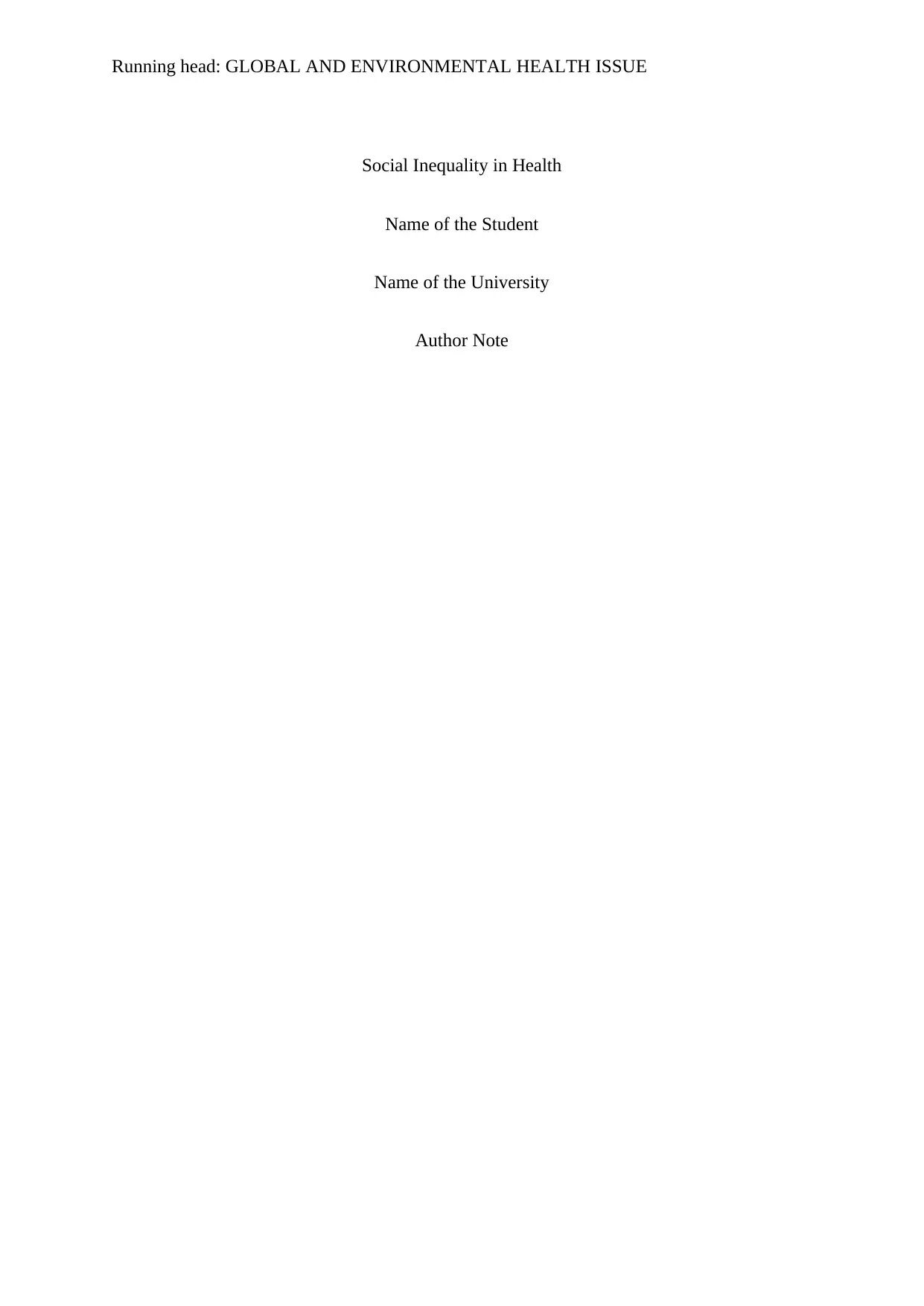
Running head: GLOBAL AND ENVIRONMENTAL HEALTH ISSUE
Social Inequality in Health
Name of the Student
Name of the University
Author Note
Social Inequality in Health
Name of the Student
Name of the University
Author Note
Paraphrase This Document
Need a fresh take? Get an instant paraphrase of this document with our AI Paraphraser
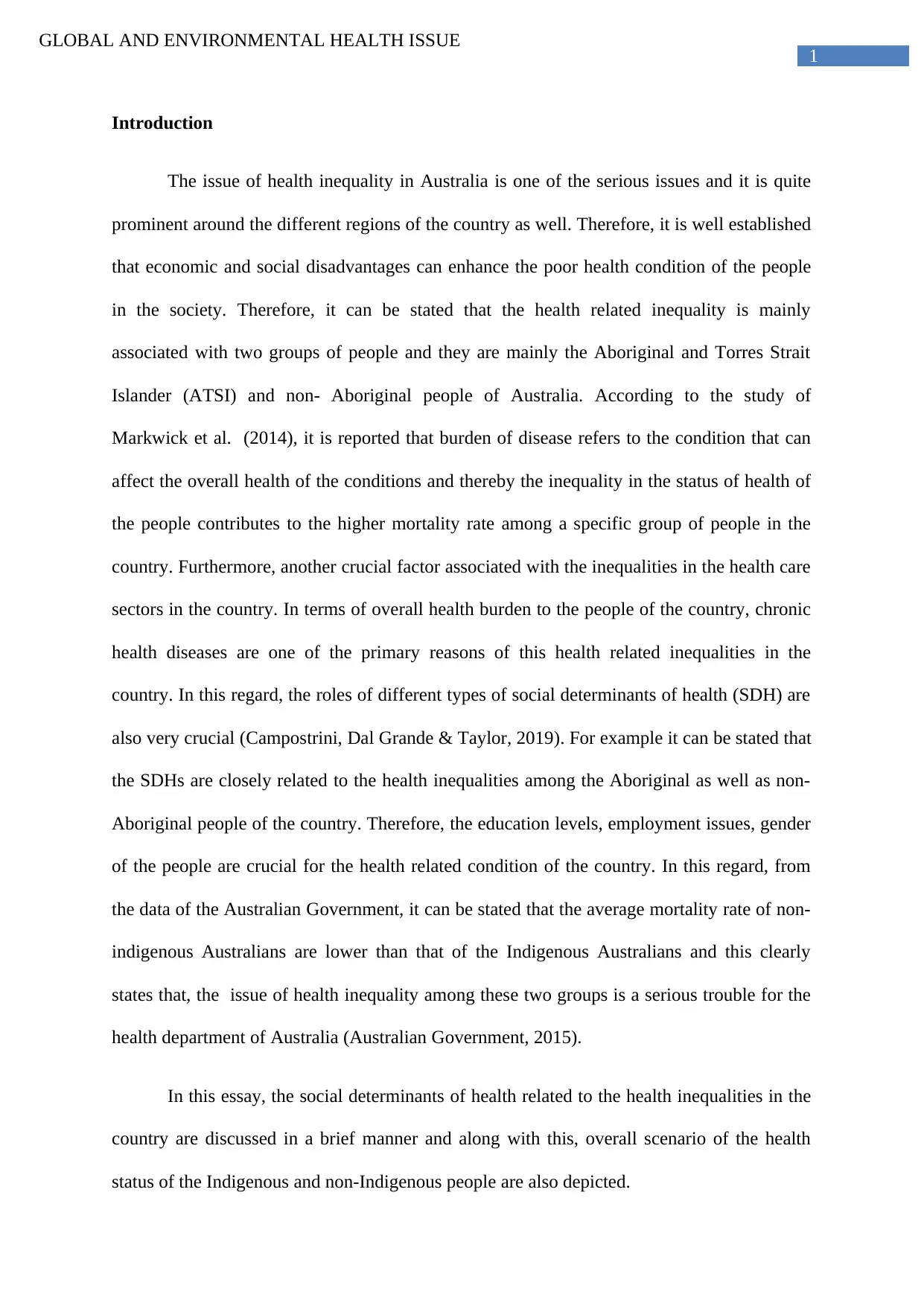
1
GLOBAL AND ENVIRONMENTAL HEALTH ISSUE
Introduction
The issue of health inequality in Australia is one of the serious issues and it is quite
prominent around the different regions of the country as well. Therefore, it is well established
that economic and social disadvantages can enhance the poor health condition of the people
in the society. Therefore, it can be stated that the health related inequality is mainly
associated with two groups of people and they are mainly the Aboriginal and Torres Strait
Islander (ATSI) and non- Aboriginal people of Australia. According to the study of
Markwick et al. (2014), it is reported that burden of disease refers to the condition that can
affect the overall health of the conditions and thereby the inequality in the status of health of
the people contributes to the higher mortality rate among a specific group of people in the
country. Furthermore, another crucial factor associated with the inequalities in the health care
sectors in the country. In terms of overall health burden to the people of the country, chronic
health diseases are one of the primary reasons of this health related inequalities in the
country. In this regard, the roles of different types of social determinants of health (SDH) are
also very crucial (Campostrini, Dal Grande & Taylor, 2019). For example it can be stated that
the SDHs are closely related to the health inequalities among the Aboriginal as well as non-
Aboriginal people of the country. Therefore, the education levels, employment issues, gender
of the people are crucial for the health related condition of the country. In this regard, from
the data of the Australian Government, it can be stated that the average mortality rate of non-
indigenous Australians are lower than that of the Indigenous Australians and this clearly
states that, the issue of health inequality among these two groups is a serious trouble for the
health department of Australia (Australian Government, 2015).
In this essay, the social determinants of health related to the health inequalities in the
country are discussed in a brief manner and along with this, overall scenario of the health
status of the Indigenous and non-Indigenous people are also depicted.
GLOBAL AND ENVIRONMENTAL HEALTH ISSUE
Introduction
The issue of health inequality in Australia is one of the serious issues and it is quite
prominent around the different regions of the country as well. Therefore, it is well established
that economic and social disadvantages can enhance the poor health condition of the people
in the society. Therefore, it can be stated that the health related inequality is mainly
associated with two groups of people and they are mainly the Aboriginal and Torres Strait
Islander (ATSI) and non- Aboriginal people of Australia. According to the study of
Markwick et al. (2014), it is reported that burden of disease refers to the condition that can
affect the overall health of the conditions and thereby the inequality in the status of health of
the people contributes to the higher mortality rate among a specific group of people in the
country. Furthermore, another crucial factor associated with the inequalities in the health care
sectors in the country. In terms of overall health burden to the people of the country, chronic
health diseases are one of the primary reasons of this health related inequalities in the
country. In this regard, the roles of different types of social determinants of health (SDH) are
also very crucial (Campostrini, Dal Grande & Taylor, 2019). For example it can be stated that
the SDHs are closely related to the health inequalities among the Aboriginal as well as non-
Aboriginal people of the country. Therefore, the education levels, employment issues, gender
of the people are crucial for the health related condition of the country. In this regard, from
the data of the Australian Government, it can be stated that the average mortality rate of non-
indigenous Australians are lower than that of the Indigenous Australians and this clearly
states that, the issue of health inequality among these two groups is a serious trouble for the
health department of Australia (Australian Government, 2015).
In this essay, the social determinants of health related to the health inequalities in the
country are discussed in a brief manner and along with this, overall scenario of the health
status of the Indigenous and non-Indigenous people are also depicted.
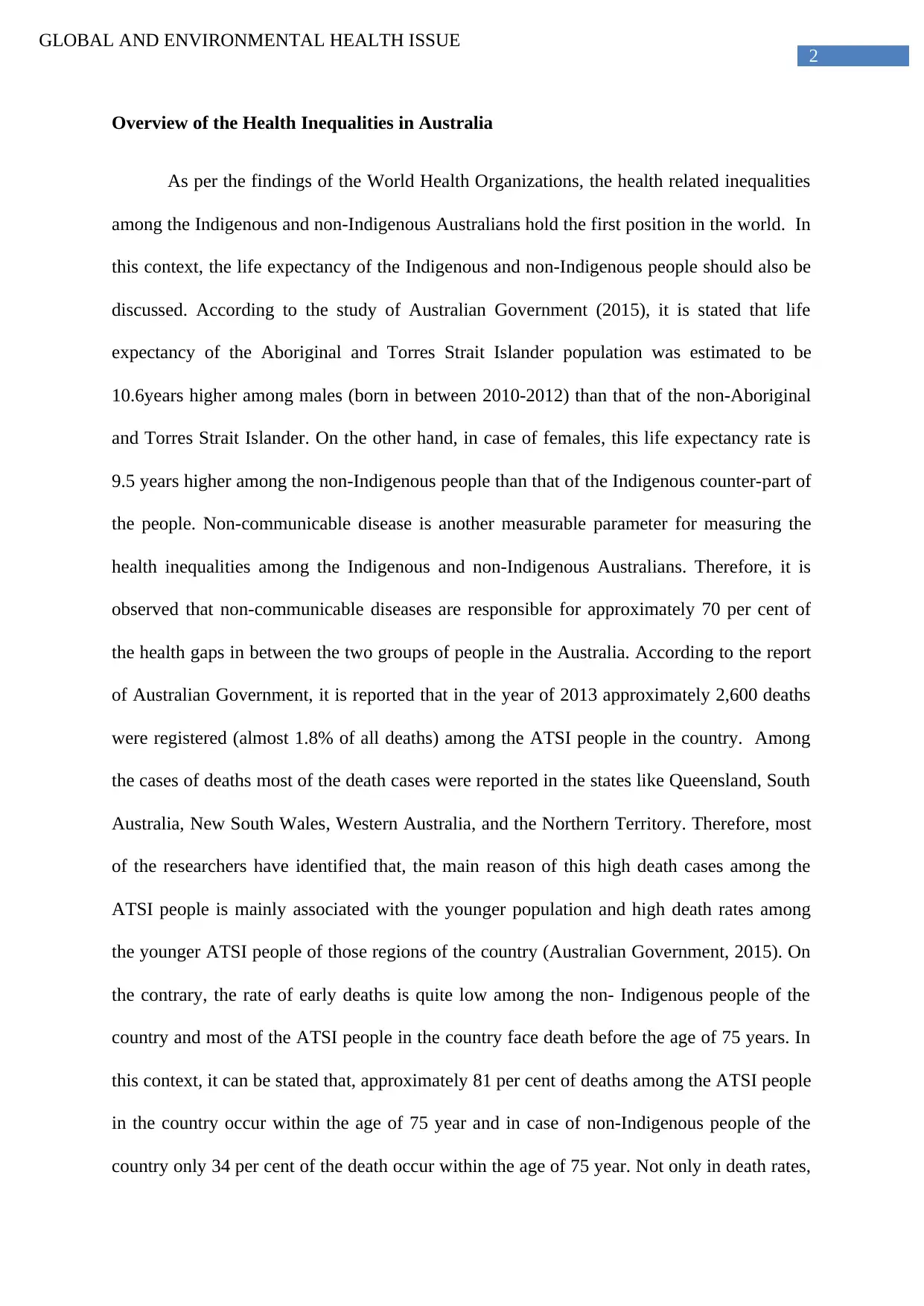
2
GLOBAL AND ENVIRONMENTAL HEALTH ISSUE
Overview of the Health Inequalities in Australia
As per the findings of the World Health Organizations, the health related inequalities
among the Indigenous and non-Indigenous Australians hold the first position in the world. In
this context, the life expectancy of the Indigenous and non-Indigenous people should also be
discussed. According to the study of Australian Government (2015), it is stated that life
expectancy of the Aboriginal and Torres Strait Islander population was estimated to be
10.6years higher among males (born in between 2010-2012) than that of the non-Aboriginal
and Torres Strait Islander. On the other hand, in case of females, this life expectancy rate is
9.5 years higher among the non-Indigenous people than that of the Indigenous counter-part of
the people. Non-communicable disease is another measurable parameter for measuring the
health inequalities among the Indigenous and non-Indigenous Australians. Therefore, it is
observed that non-communicable diseases are responsible for approximately 70 per cent of
the health gaps in between the two groups of people in the Australia. According to the report
of Australian Government, it is reported that in the year of 2013 approximately 2,600 deaths
were registered (almost 1.8% of all deaths) among the ATSI people in the country. Among
the cases of deaths most of the death cases were reported in the states like Queensland, South
Australia, New South Wales, Western Australia, and the Northern Territory. Therefore, most
of the researchers have identified that, the main reason of this high death cases among the
ATSI people is mainly associated with the younger population and high death rates among
the younger ATSI people of those regions of the country (Australian Government, 2015). On
the contrary, the rate of early deaths is quite low among the non- Indigenous people of the
country and most of the ATSI people in the country face death before the age of 75 years. In
this context, it can be stated that, approximately 81 per cent of deaths among the ATSI people
in the country occur within the age of 75 year and in case of non-Indigenous people of the
country only 34 per cent of the death occur within the age of 75 year. Not only in death rates,
GLOBAL AND ENVIRONMENTAL HEALTH ISSUE
Overview of the Health Inequalities in Australia
As per the findings of the World Health Organizations, the health related inequalities
among the Indigenous and non-Indigenous Australians hold the first position in the world. In
this context, the life expectancy of the Indigenous and non-Indigenous people should also be
discussed. According to the study of Australian Government (2015), it is stated that life
expectancy of the Aboriginal and Torres Strait Islander population was estimated to be
10.6years higher among males (born in between 2010-2012) than that of the non-Aboriginal
and Torres Strait Islander. On the other hand, in case of females, this life expectancy rate is
9.5 years higher among the non-Indigenous people than that of the Indigenous counter-part of
the people. Non-communicable disease is another measurable parameter for measuring the
health inequalities among the Indigenous and non-Indigenous Australians. Therefore, it is
observed that non-communicable diseases are responsible for approximately 70 per cent of
the health gaps in between the two groups of people in the Australia. According to the report
of Australian Government, it is reported that in the year of 2013 approximately 2,600 deaths
were registered (almost 1.8% of all deaths) among the ATSI people in the country. Among
the cases of deaths most of the death cases were reported in the states like Queensland, South
Australia, New South Wales, Western Australia, and the Northern Territory. Therefore, most
of the researchers have identified that, the main reason of this high death cases among the
ATSI people is mainly associated with the younger population and high death rates among
the younger ATSI people of those regions of the country (Australian Government, 2015). On
the contrary, the rate of early deaths is quite low among the non- Indigenous people of the
country and most of the ATSI people in the country face death before the age of 75 years. In
this context, it can be stated that, approximately 81 per cent of deaths among the ATSI people
in the country occur within the age of 75 year and in case of non-Indigenous people of the
country only 34 per cent of the death occur within the age of 75 year. Not only in death rates,
⊘ This is a preview!⊘
Do you want full access?
Subscribe today to unlock all pages.

Trusted by 1+ million students worldwide
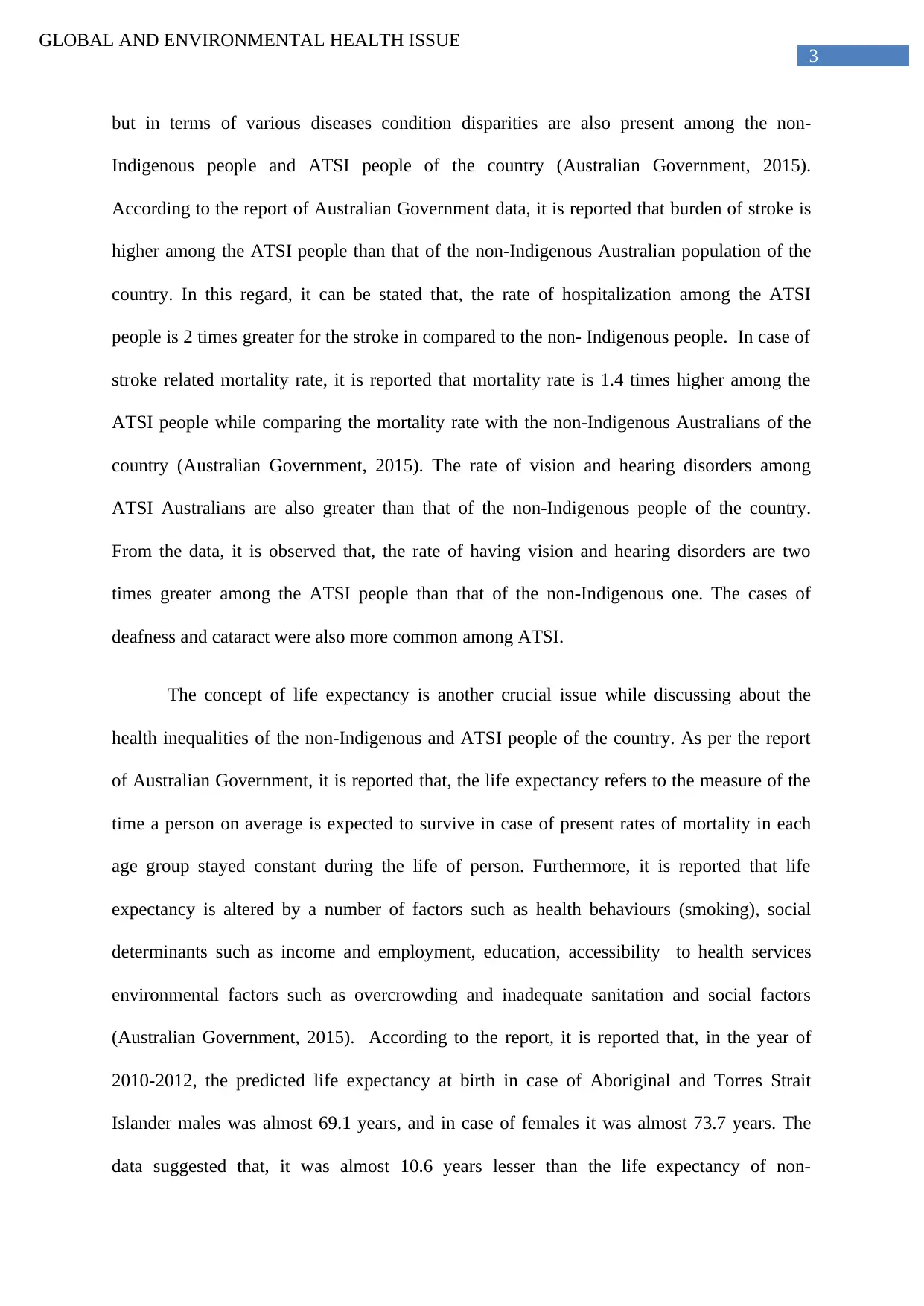
3
GLOBAL AND ENVIRONMENTAL HEALTH ISSUE
but in terms of various diseases condition disparities are also present among the non-
Indigenous people and ATSI people of the country (Australian Government, 2015).
According to the report of Australian Government data, it is reported that burden of stroke is
higher among the ATSI people than that of the non-Indigenous Australian population of the
country. In this regard, it can be stated that, the rate of hospitalization among the ATSI
people is 2 times greater for the stroke in compared to the non- Indigenous people. In case of
stroke related mortality rate, it is reported that mortality rate is 1.4 times higher among the
ATSI people while comparing the mortality rate with the non-Indigenous Australians of the
country (Australian Government, 2015). The rate of vision and hearing disorders among
ATSI Australians are also greater than that of the non-Indigenous people of the country.
From the data, it is observed that, the rate of having vision and hearing disorders are two
times greater among the ATSI people than that of the non-Indigenous one. The cases of
deafness and cataract were also more common among ATSI.
The concept of life expectancy is another crucial issue while discussing about the
health inequalities of the non-Indigenous and ATSI people of the country. As per the report
of Australian Government, it is reported that, the life expectancy refers to the measure of the
time a person on average is expected to survive in case of present rates of mortality in each
age group stayed constant during the life of person. Furthermore, it is reported that life
expectancy is altered by a number of factors such as health behaviours (smoking), social
determinants such as income and employment, education, accessibility to health services
environmental factors such as overcrowding and inadequate sanitation and social factors
(Australian Government, 2015). According to the report, it is reported that, in the year of
2010-2012, the predicted life expectancy at birth in case of Aboriginal and Torres Strait
Islander males was almost 69.1 years, and in case of females it was almost 73.7 years. The
data suggested that, it was almost 10.6 years lesser than the life expectancy of non-
GLOBAL AND ENVIRONMENTAL HEALTH ISSUE
but in terms of various diseases condition disparities are also present among the non-
Indigenous people and ATSI people of the country (Australian Government, 2015).
According to the report of Australian Government data, it is reported that burden of stroke is
higher among the ATSI people than that of the non-Indigenous Australian population of the
country. In this regard, it can be stated that, the rate of hospitalization among the ATSI
people is 2 times greater for the stroke in compared to the non- Indigenous people. In case of
stroke related mortality rate, it is reported that mortality rate is 1.4 times higher among the
ATSI people while comparing the mortality rate with the non-Indigenous Australians of the
country (Australian Government, 2015). The rate of vision and hearing disorders among
ATSI Australians are also greater than that of the non-Indigenous people of the country.
From the data, it is observed that, the rate of having vision and hearing disorders are two
times greater among the ATSI people than that of the non-Indigenous one. The cases of
deafness and cataract were also more common among ATSI.
The concept of life expectancy is another crucial issue while discussing about the
health inequalities of the non-Indigenous and ATSI people of the country. As per the report
of Australian Government, it is reported that, the life expectancy refers to the measure of the
time a person on average is expected to survive in case of present rates of mortality in each
age group stayed constant during the life of person. Furthermore, it is reported that life
expectancy is altered by a number of factors such as health behaviours (smoking), social
determinants such as income and employment, education, accessibility to health services
environmental factors such as overcrowding and inadequate sanitation and social factors
(Australian Government, 2015). According to the report, it is reported that, in the year of
2010-2012, the predicted life expectancy at birth in case of Aboriginal and Torres Strait
Islander males was almost 69.1 years, and in case of females it was almost 73.7 years. The
data suggested that, it was almost 10.6 years lesser than the life expectancy of non-
Paraphrase This Document
Need a fresh take? Get an instant paraphrase of this document with our AI Paraphraser
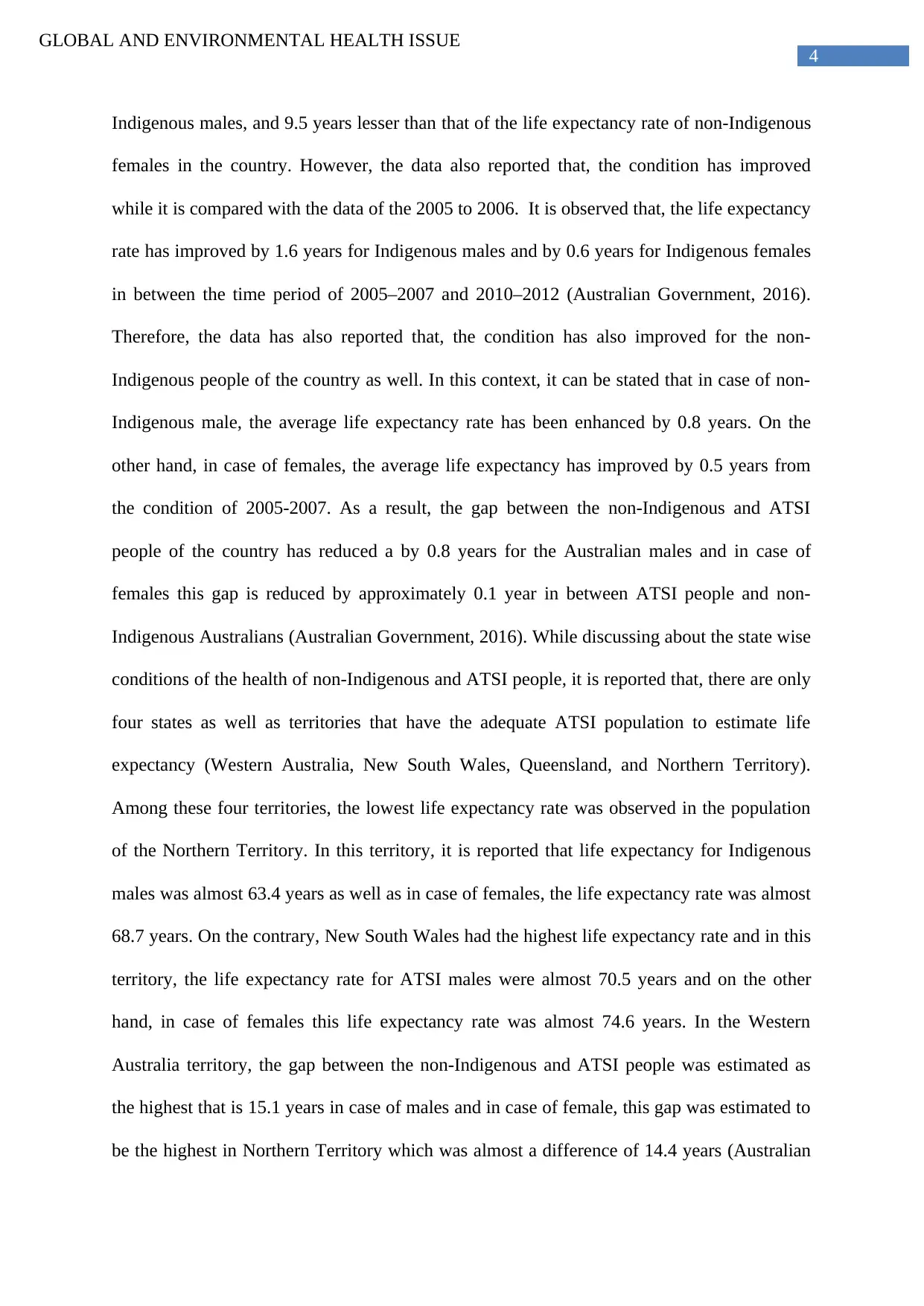
4
GLOBAL AND ENVIRONMENTAL HEALTH ISSUE
Indigenous males, and 9.5 years lesser than that of the life expectancy rate of non-Indigenous
females in the country. However, the data also reported that, the condition has improved
while it is compared with the data of the 2005 to 2006. It is observed that, the life expectancy
rate has improved by 1.6 years for Indigenous males and by 0.6 years for Indigenous females
in between the time period of 2005–2007 and 2010–2012 (Australian Government, 2016).
Therefore, the data has also reported that, the condition has also improved for the non-
Indigenous people of the country as well. In this context, it can be stated that in case of non-
Indigenous male, the average life expectancy rate has been enhanced by 0.8 years. On the
other hand, in case of females, the average life expectancy has improved by 0.5 years from
the condition of 2005-2007. As a result, the gap between the non-Indigenous and ATSI
people of the country has reduced a by 0.8 years for the Australian males and in case of
females this gap is reduced by approximately 0.1 year in between ATSI people and non-
Indigenous Australians (Australian Government, 2016). While discussing about the state wise
conditions of the health of non-Indigenous and ATSI people, it is reported that, there are only
four states as well as territories that have the adequate ATSI population to estimate life
expectancy (Western Australia, New South Wales, Queensland, and Northern Territory).
Among these four territories, the lowest life expectancy rate was observed in the population
of the Northern Territory. In this territory, it is reported that life expectancy for Indigenous
males was almost 63.4 years as well as in case of females, the life expectancy rate was almost
68.7 years. On the contrary, New South Wales had the highest life expectancy rate and in this
territory, the life expectancy rate for ATSI males were almost 70.5 years and on the other
hand, in case of females this life expectancy rate was almost 74.6 years. In the Western
Australia territory, the gap between the non-Indigenous and ATSI people was estimated as
the highest that is 15.1 years in case of males and in case of female, this gap was estimated to
be the highest in Northern Territory which was almost a difference of 14.4 years (Australian
GLOBAL AND ENVIRONMENTAL HEALTH ISSUE
Indigenous males, and 9.5 years lesser than that of the life expectancy rate of non-Indigenous
females in the country. However, the data also reported that, the condition has improved
while it is compared with the data of the 2005 to 2006. It is observed that, the life expectancy
rate has improved by 1.6 years for Indigenous males and by 0.6 years for Indigenous females
in between the time period of 2005–2007 and 2010–2012 (Australian Government, 2016).
Therefore, the data has also reported that, the condition has also improved for the non-
Indigenous people of the country as well. In this context, it can be stated that in case of non-
Indigenous male, the average life expectancy rate has been enhanced by 0.8 years. On the
other hand, in case of females, the average life expectancy has improved by 0.5 years from
the condition of 2005-2007. As a result, the gap between the non-Indigenous and ATSI
people of the country has reduced a by 0.8 years for the Australian males and in case of
females this gap is reduced by approximately 0.1 year in between ATSI people and non-
Indigenous Australians (Australian Government, 2016). While discussing about the state wise
conditions of the health of non-Indigenous and ATSI people, it is reported that, there are only
four states as well as territories that have the adequate ATSI population to estimate life
expectancy (Western Australia, New South Wales, Queensland, and Northern Territory).
Among these four territories, the lowest life expectancy rate was observed in the population
of the Northern Territory. In this territory, it is reported that life expectancy for Indigenous
males was almost 63.4 years as well as in case of females, the life expectancy rate was almost
68.7 years. On the contrary, New South Wales had the highest life expectancy rate and in this
territory, the life expectancy rate for ATSI males were almost 70.5 years and on the other
hand, in case of females this life expectancy rate was almost 74.6 years. In the Western
Australia territory, the gap between the non-Indigenous and ATSI people was estimated as
the highest that is 15.1 years in case of males and in case of female, this gap was estimated to
be the highest in Northern Territory which was almost a difference of 14.4 years (Australian
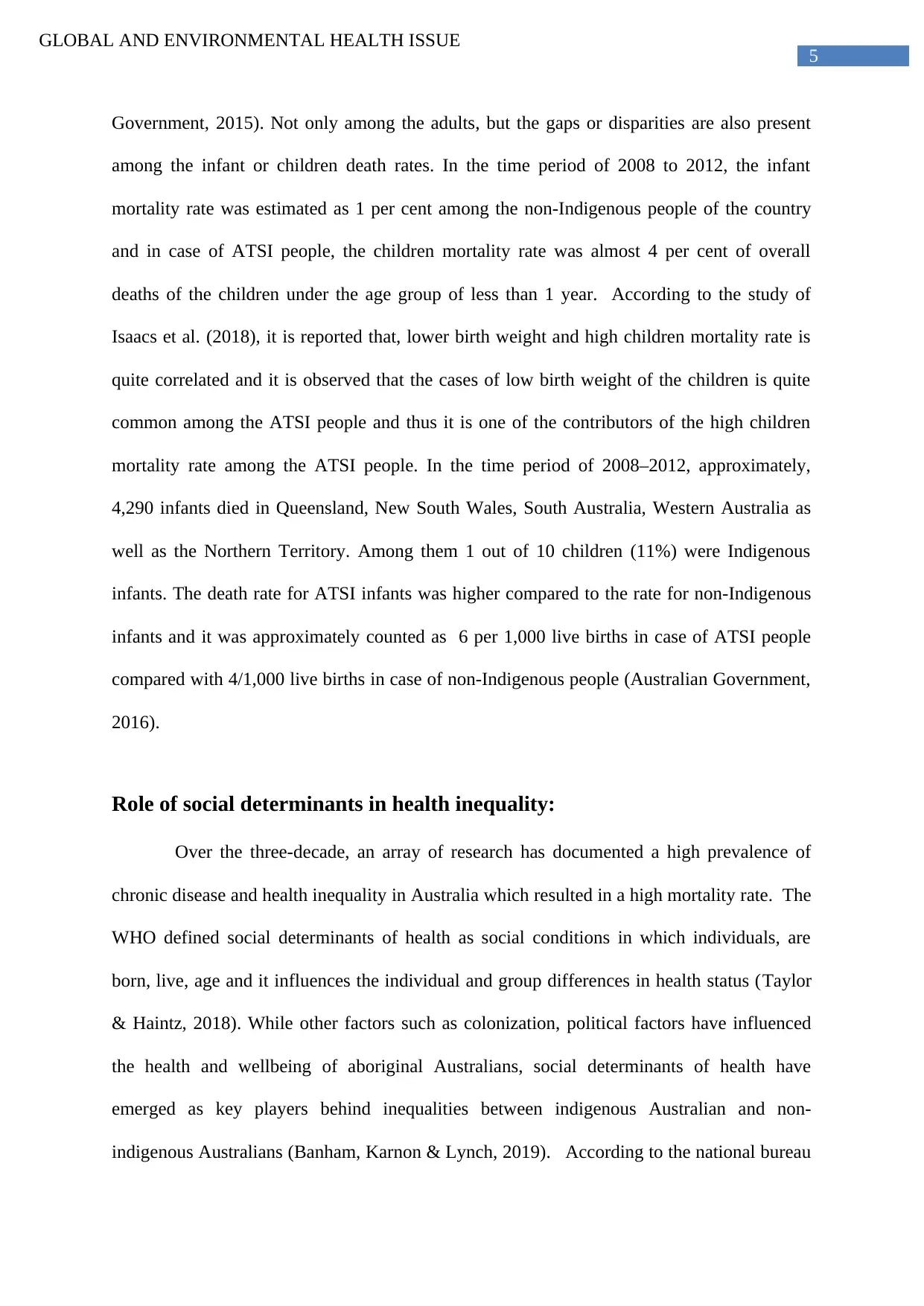
5
GLOBAL AND ENVIRONMENTAL HEALTH ISSUE
Government, 2015). Not only among the adults, but the gaps or disparities are also present
among the infant or children death rates. In the time period of 2008 to 2012, the infant
mortality rate was estimated as 1 per cent among the non-Indigenous people of the country
and in case of ATSI people, the children mortality rate was almost 4 per cent of overall
deaths of the children under the age group of less than 1 year. According to the study of
Isaacs et al. (2018), it is reported that, lower birth weight and high children mortality rate is
quite correlated and it is observed that the cases of low birth weight of the children is quite
common among the ATSI people and thus it is one of the contributors of the high children
mortality rate among the ATSI people. In the time period of 2008–2012, approximately,
4,290 infants died in Queensland, New South Wales, South Australia, Western Australia as
well as the Northern Territory. Among them 1 out of 10 children (11%) were Indigenous
infants. The death rate for ATSI infants was higher compared to the rate for non-Indigenous
infants and it was approximately counted as 6 per 1,000 live births in case of ATSI people
compared with 4/1,000 live births in case of non-Indigenous people (Australian Government,
2016).
Role of social determinants in health inequality:
Over the three-decade, an array of research has documented a high prevalence of
chronic disease and health inequality in Australia which resulted in a high mortality rate. The
WHO defined social determinants of health as social conditions in which individuals, are
born, live, age and it influences the individual and group differences in health status (Taylor
& Haintz, 2018). While other factors such as colonization, political factors have influenced
the health and wellbeing of aboriginal Australians, social determinants of health have
emerged as key players behind inequalities between indigenous Australian and non-
indigenous Australians (Banham, Karnon & Lynch, 2019). According to the national bureau
GLOBAL AND ENVIRONMENTAL HEALTH ISSUE
Government, 2015). Not only among the adults, but the gaps or disparities are also present
among the infant or children death rates. In the time period of 2008 to 2012, the infant
mortality rate was estimated as 1 per cent among the non-Indigenous people of the country
and in case of ATSI people, the children mortality rate was almost 4 per cent of overall
deaths of the children under the age group of less than 1 year. According to the study of
Isaacs et al. (2018), it is reported that, lower birth weight and high children mortality rate is
quite correlated and it is observed that the cases of low birth weight of the children is quite
common among the ATSI people and thus it is one of the contributors of the high children
mortality rate among the ATSI people. In the time period of 2008–2012, approximately,
4,290 infants died in Queensland, New South Wales, South Australia, Western Australia as
well as the Northern Territory. Among them 1 out of 10 children (11%) were Indigenous
infants. The death rate for ATSI infants was higher compared to the rate for non-Indigenous
infants and it was approximately counted as 6 per 1,000 live births in case of ATSI people
compared with 4/1,000 live births in case of non-Indigenous people (Australian Government,
2016).
Role of social determinants in health inequality:
Over the three-decade, an array of research has documented a high prevalence of
chronic disease and health inequality in Australia which resulted in a high mortality rate. The
WHO defined social determinants of health as social conditions in which individuals, are
born, live, age and it influences the individual and group differences in health status (Taylor
& Haintz, 2018). While other factors such as colonization, political factors have influenced
the health and wellbeing of aboriginal Australians, social determinants of health have
emerged as key players behind inequalities between indigenous Australian and non-
indigenous Australians (Banham, Karnon & Lynch, 2019). According to the national bureau
⊘ This is a preview!⊘
Do you want full access?
Subscribe today to unlock all pages.

Trusted by 1+ million students worldwide
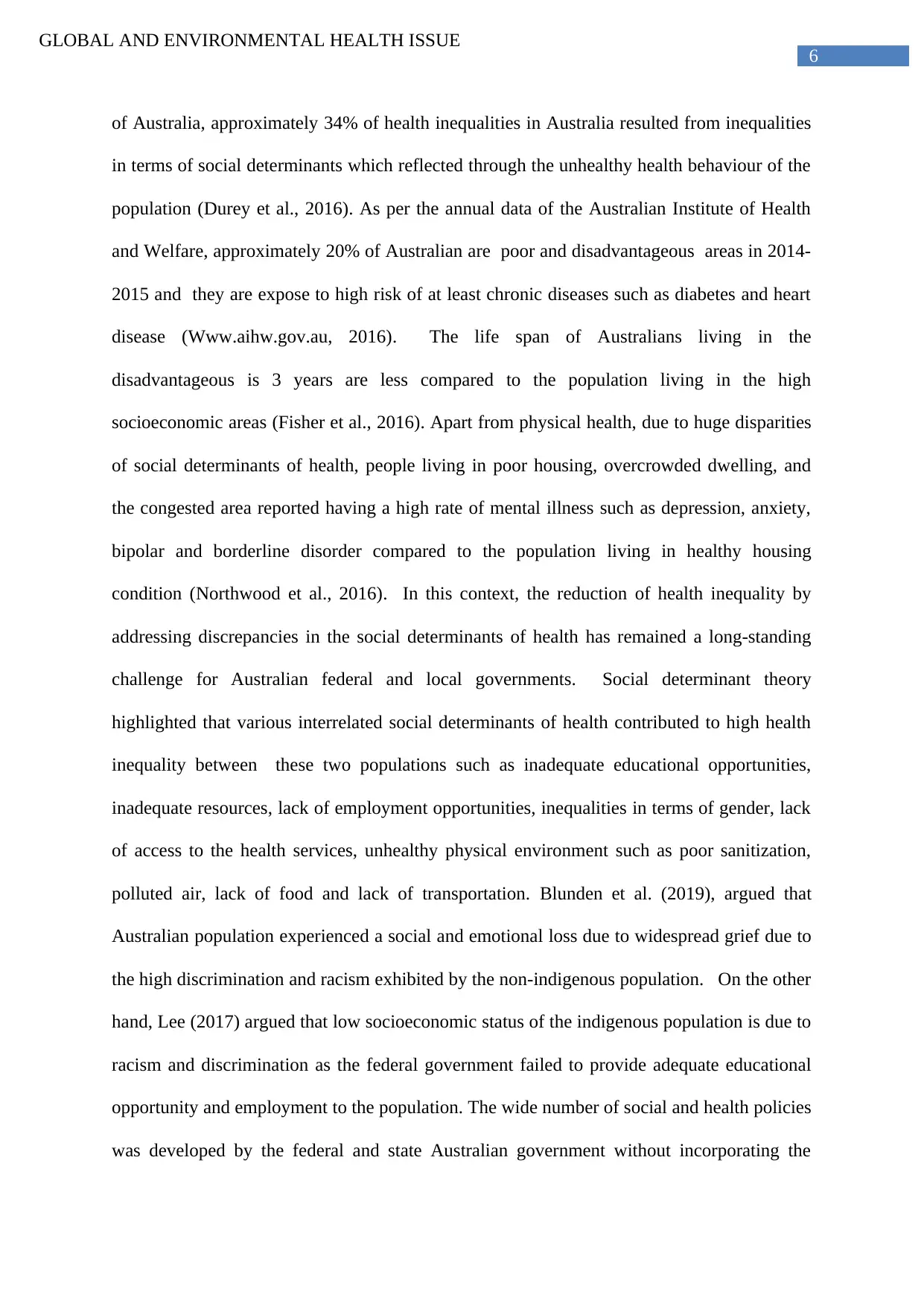
6
GLOBAL AND ENVIRONMENTAL HEALTH ISSUE
of Australia, approximately 34% of health inequalities in Australia resulted from inequalities
in terms of social determinants which reflected through the unhealthy health behaviour of the
population (Durey et al., 2016). As per the annual data of the Australian Institute of Health
and Welfare, approximately 20% of Australian are poor and disadvantageous areas in 2014-
2015 and they are expose to high risk of at least chronic diseases such as diabetes and heart
disease (Www.aihw.gov.au, 2016). The life span of Australians living in the
disadvantageous is 3 years are less compared to the population living in the high
socioeconomic areas (Fisher et al., 2016). Apart from physical health, due to huge disparities
of social determinants of health, people living in poor housing, overcrowded dwelling, and
the congested area reported having a high rate of mental illness such as depression, anxiety,
bipolar and borderline disorder compared to the population living in healthy housing
condition (Northwood et al., 2016). In this context, the reduction of health inequality by
addressing discrepancies in the social determinants of health has remained a long-standing
challenge for Australian federal and local governments. Social determinant theory
highlighted that various interrelated social determinants of health contributed to high health
inequality between these two populations such as inadequate educational opportunities,
inadequate resources, lack of employment opportunities, inequalities in terms of gender, lack
of access to the health services, unhealthy physical environment such as poor sanitization,
polluted air, lack of food and lack of transportation. Blunden et al. (2019), argued that
Australian population experienced a social and emotional loss due to widespread grief due to
the high discrimination and racism exhibited by the non-indigenous population. On the other
hand, Lee (2017) argued that low socioeconomic status of the indigenous population is due to
racism and discrimination as the federal government failed to provide adequate educational
opportunity and employment to the population. The wide number of social and health policies
was developed by the federal and state Australian government without incorporating the
GLOBAL AND ENVIRONMENTAL HEALTH ISSUE
of Australia, approximately 34% of health inequalities in Australia resulted from inequalities
in terms of social determinants which reflected through the unhealthy health behaviour of the
population (Durey et al., 2016). As per the annual data of the Australian Institute of Health
and Welfare, approximately 20% of Australian are poor and disadvantageous areas in 2014-
2015 and they are expose to high risk of at least chronic diseases such as diabetes and heart
disease (Www.aihw.gov.au, 2016). The life span of Australians living in the
disadvantageous is 3 years are less compared to the population living in the high
socioeconomic areas (Fisher et al., 2016). Apart from physical health, due to huge disparities
of social determinants of health, people living in poor housing, overcrowded dwelling, and
the congested area reported having a high rate of mental illness such as depression, anxiety,
bipolar and borderline disorder compared to the population living in healthy housing
condition (Northwood et al., 2016). In this context, the reduction of health inequality by
addressing discrepancies in the social determinants of health has remained a long-standing
challenge for Australian federal and local governments. Social determinant theory
highlighted that various interrelated social determinants of health contributed to high health
inequality between these two populations such as inadequate educational opportunities,
inadequate resources, lack of employment opportunities, inequalities in terms of gender, lack
of access to the health services, unhealthy physical environment such as poor sanitization,
polluted air, lack of food and lack of transportation. Blunden et al. (2019), argued that
Australian population experienced a social and emotional loss due to widespread grief due to
the high discrimination and racism exhibited by the non-indigenous population. On the other
hand, Lee (2017) argued that low socioeconomic status of the indigenous population is due to
racism and discrimination as the federal government failed to provide adequate educational
opportunity and employment to the population. The wide number of social and health policies
was developed by the federal and state Australian government without incorporating the
Paraphrase This Document
Need a fresh take? Get an instant paraphrase of this document with our AI Paraphraser
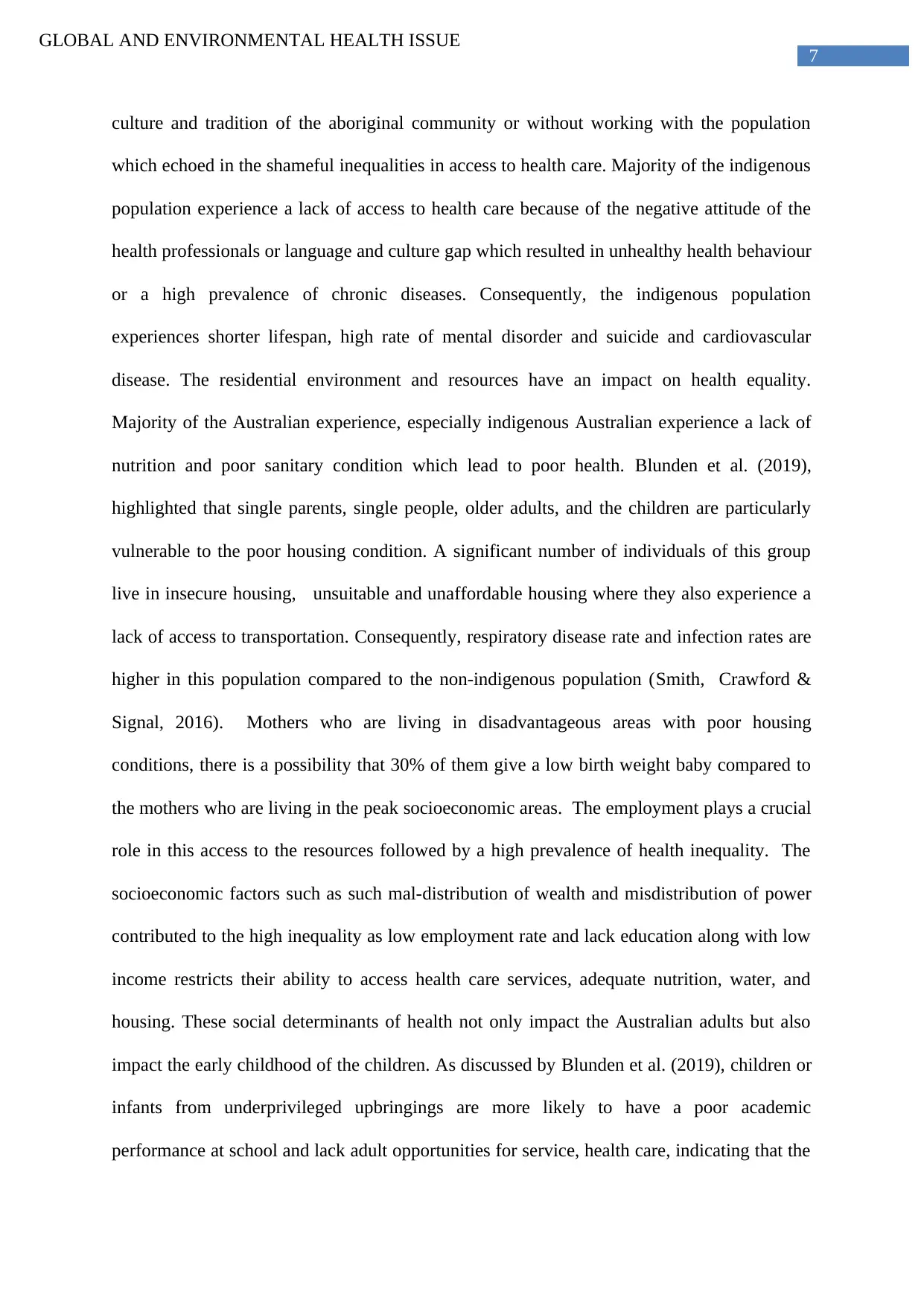
7
GLOBAL AND ENVIRONMENTAL HEALTH ISSUE
culture and tradition of the aboriginal community or without working with the population
which echoed in the shameful inequalities in access to health care. Majority of the indigenous
population experience a lack of access to health care because of the negative attitude of the
health professionals or language and culture gap which resulted in unhealthy health behaviour
or a high prevalence of chronic diseases. Consequently, the indigenous population
experiences shorter lifespan, high rate of mental disorder and suicide and cardiovascular
disease. The residential environment and resources have an impact on health equality.
Majority of the Australian experience, especially indigenous Australian experience a lack of
nutrition and poor sanitary condition which lead to poor health. Blunden et al. (2019),
highlighted that single parents, single people, older adults, and the children are particularly
vulnerable to the poor housing condition. A significant number of individuals of this group
live in insecure housing, unsuitable and unaffordable housing where they also experience a
lack of access to transportation. Consequently, respiratory disease rate and infection rates are
higher in this population compared to the non-indigenous population (Smith, Crawford &
Signal, 2016). Mothers who are living in disadvantageous areas with poor housing
conditions, there is a possibility that 30% of them give a low birth weight baby compared to
the mothers who are living in the peak socioeconomic areas. The employment plays a crucial
role in this access to the resources followed by a high prevalence of health inequality. The
socioeconomic factors such as such mal-distribution of wealth and misdistribution of power
contributed to the high inequality as low employment rate and lack education along with low
income restricts their ability to access health care services, adequate nutrition, water, and
housing. These social determinants of health not only impact the Australian adults but also
impact the early childhood of the children. As discussed by Blunden et al. (2019), children or
infants from underprivileged upbringings are more likely to have a poor academic
performance at school and lack adult opportunities for service, health care, indicating that the
GLOBAL AND ENVIRONMENTAL HEALTH ISSUE
culture and tradition of the aboriginal community or without working with the population
which echoed in the shameful inequalities in access to health care. Majority of the indigenous
population experience a lack of access to health care because of the negative attitude of the
health professionals or language and culture gap which resulted in unhealthy health behaviour
or a high prevalence of chronic diseases. Consequently, the indigenous population
experiences shorter lifespan, high rate of mental disorder and suicide and cardiovascular
disease. The residential environment and resources have an impact on health equality.
Majority of the Australian experience, especially indigenous Australian experience a lack of
nutrition and poor sanitary condition which lead to poor health. Blunden et al. (2019),
highlighted that single parents, single people, older adults, and the children are particularly
vulnerable to the poor housing condition. A significant number of individuals of this group
live in insecure housing, unsuitable and unaffordable housing where they also experience a
lack of access to transportation. Consequently, respiratory disease rate and infection rates are
higher in this population compared to the non-indigenous population (Smith, Crawford &
Signal, 2016). Mothers who are living in disadvantageous areas with poor housing
conditions, there is a possibility that 30% of them give a low birth weight baby compared to
the mothers who are living in the peak socioeconomic areas. The employment plays a crucial
role in this access to the resources followed by a high prevalence of health inequality. The
socioeconomic factors such as such mal-distribution of wealth and misdistribution of power
contributed to the high inequality as low employment rate and lack education along with low
income restricts their ability to access health care services, adequate nutrition, water, and
housing. These social determinants of health not only impact the Australian adults but also
impact the early childhood of the children. As discussed by Blunden et al. (2019), children or
infants from underprivileged upbringings are more likely to have a poor academic
performance at school and lack adult opportunities for service, health care, indicating that the
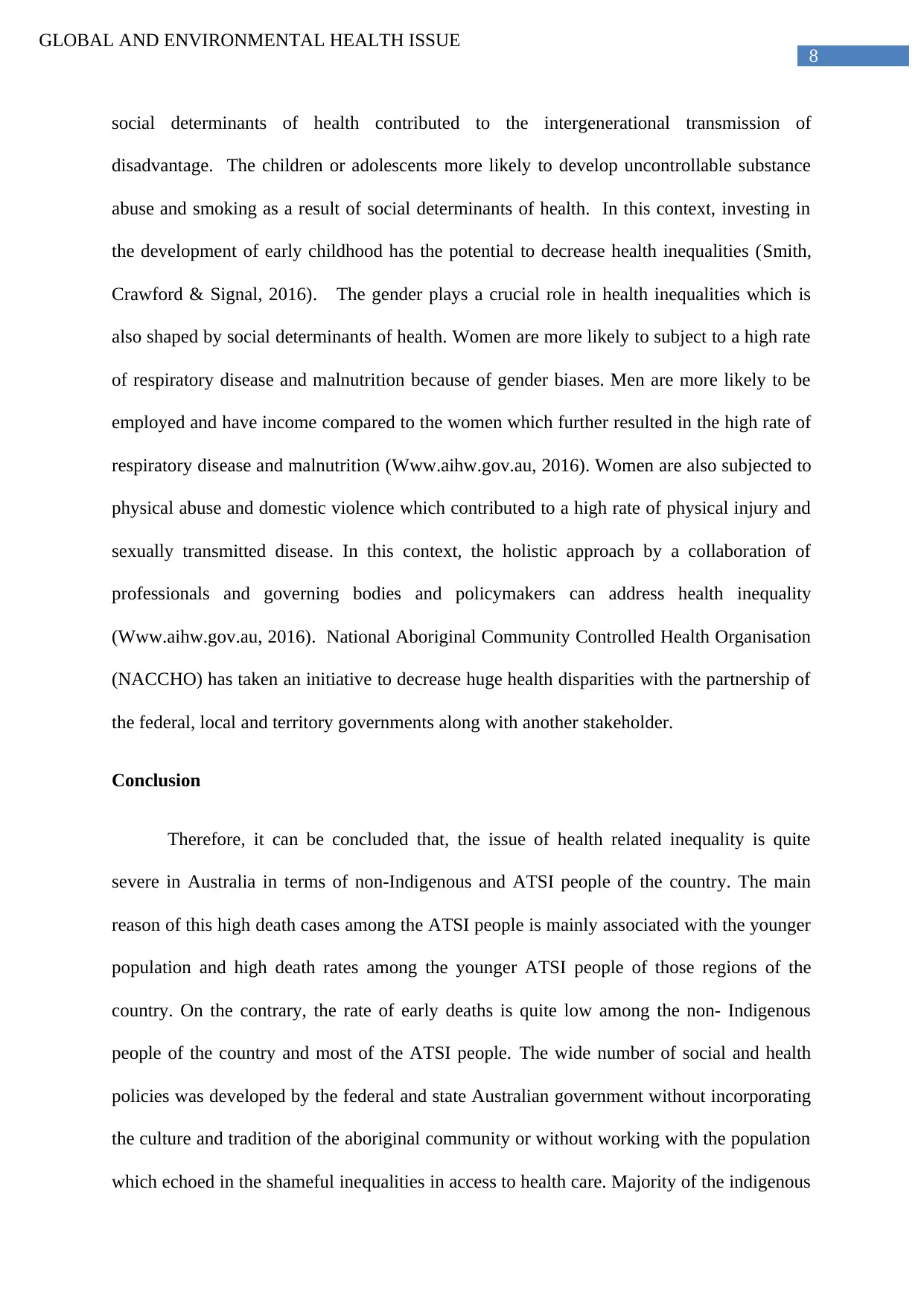
8
GLOBAL AND ENVIRONMENTAL HEALTH ISSUE
social determinants of health contributed to the intergenerational transmission of
disadvantage. The children or adolescents more likely to develop uncontrollable substance
abuse and smoking as a result of social determinants of health. In this context, investing in
the development of early childhood has the potential to decrease health inequalities (Smith,
Crawford & Signal, 2016). The gender plays a crucial role in health inequalities which is
also shaped by social determinants of health. Women are more likely to subject to a high rate
of respiratory disease and malnutrition because of gender biases. Men are more likely to be
employed and have income compared to the women which further resulted in the high rate of
respiratory disease and malnutrition (Www.aihw.gov.au, 2016). Women are also subjected to
physical abuse and domestic violence which contributed to a high rate of physical injury and
sexually transmitted disease. In this context, the holistic approach by a collaboration of
professionals and governing bodies and policymakers can address health inequality
(Www.aihw.gov.au, 2016). National Aboriginal Community Controlled Health Organisation
(NACCHO) has taken an initiative to decrease huge health disparities with the partnership of
the federal, local and territory governments along with another stakeholder.
Conclusion
Therefore, it can be concluded that, the issue of health related inequality is quite
severe in Australia in terms of non-Indigenous and ATSI people of the country. The main
reason of this high death cases among the ATSI people is mainly associated with the younger
population and high death rates among the younger ATSI people of those regions of the
country. On the contrary, the rate of early deaths is quite low among the non- Indigenous
people of the country and most of the ATSI people. The wide number of social and health
policies was developed by the federal and state Australian government without incorporating
the culture and tradition of the aboriginal community or without working with the population
which echoed in the shameful inequalities in access to health care. Majority of the indigenous
GLOBAL AND ENVIRONMENTAL HEALTH ISSUE
social determinants of health contributed to the intergenerational transmission of
disadvantage. The children or adolescents more likely to develop uncontrollable substance
abuse and smoking as a result of social determinants of health. In this context, investing in
the development of early childhood has the potential to decrease health inequalities (Smith,
Crawford & Signal, 2016). The gender plays a crucial role in health inequalities which is
also shaped by social determinants of health. Women are more likely to subject to a high rate
of respiratory disease and malnutrition because of gender biases. Men are more likely to be
employed and have income compared to the women which further resulted in the high rate of
respiratory disease and malnutrition (Www.aihw.gov.au, 2016). Women are also subjected to
physical abuse and domestic violence which contributed to a high rate of physical injury and
sexually transmitted disease. In this context, the holistic approach by a collaboration of
professionals and governing bodies and policymakers can address health inequality
(Www.aihw.gov.au, 2016). National Aboriginal Community Controlled Health Organisation
(NACCHO) has taken an initiative to decrease huge health disparities with the partnership of
the federal, local and territory governments along with another stakeholder.
Conclusion
Therefore, it can be concluded that, the issue of health related inequality is quite
severe in Australia in terms of non-Indigenous and ATSI people of the country. The main
reason of this high death cases among the ATSI people is mainly associated with the younger
population and high death rates among the younger ATSI people of those regions of the
country. On the contrary, the rate of early deaths is quite low among the non- Indigenous
people of the country and most of the ATSI people. The wide number of social and health
policies was developed by the federal and state Australian government without incorporating
the culture and tradition of the aboriginal community or without working with the population
which echoed in the shameful inequalities in access to health care. Majority of the indigenous
⊘ This is a preview!⊘
Do you want full access?
Subscribe today to unlock all pages.

Trusted by 1+ million students worldwide
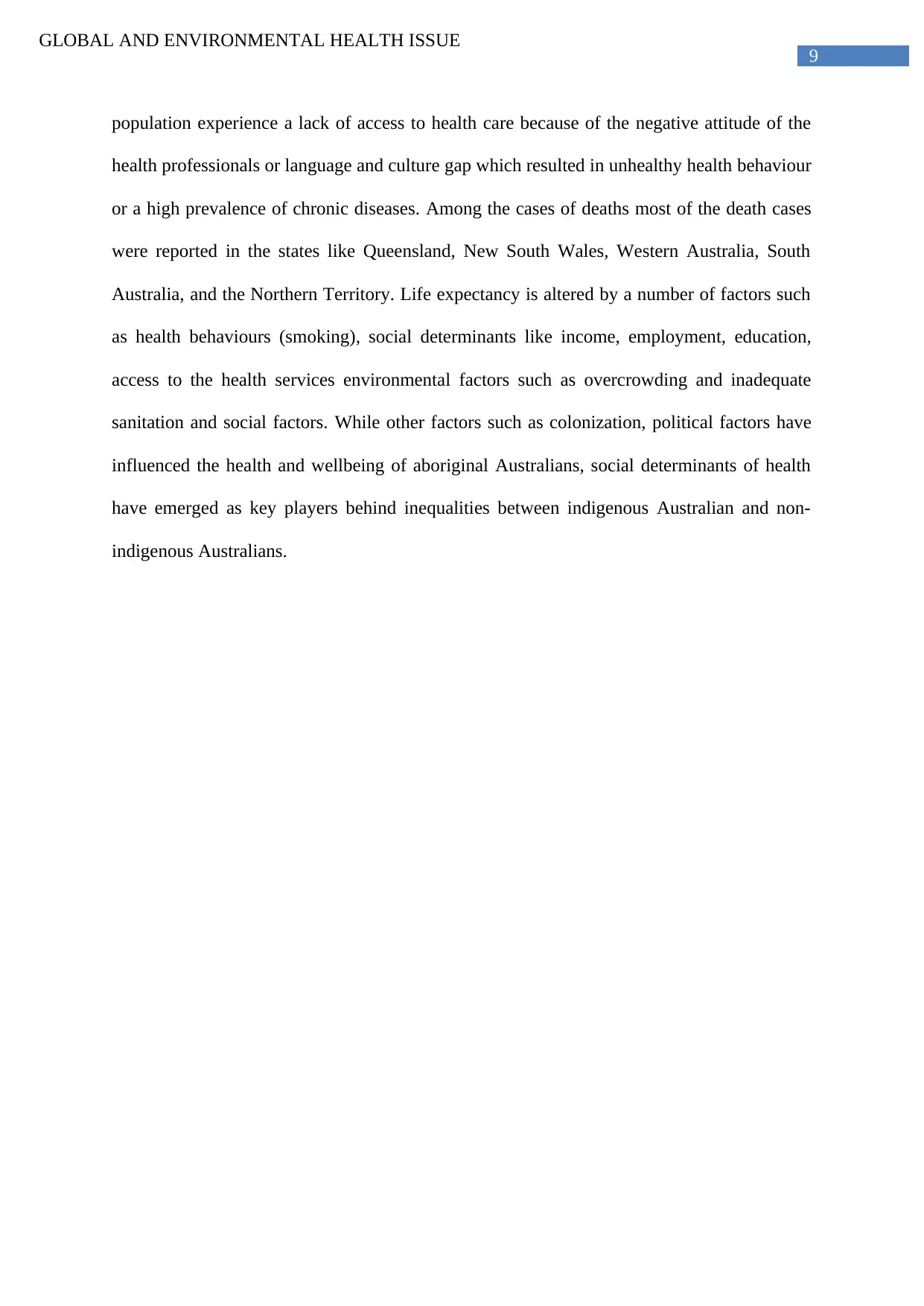
9
GLOBAL AND ENVIRONMENTAL HEALTH ISSUE
population experience a lack of access to health care because of the negative attitude of the
health professionals or language and culture gap which resulted in unhealthy health behaviour
or a high prevalence of chronic diseases. Among the cases of deaths most of the death cases
were reported in the states like Queensland, New South Wales, Western Australia, South
Australia, and the Northern Territory. Life expectancy is altered by a number of factors such
as health behaviours (smoking), social determinants like income, employment, education,
access to the health services environmental factors such as overcrowding and inadequate
sanitation and social factors. While other factors such as colonization, political factors have
influenced the health and wellbeing of aboriginal Australians, social determinants of health
have emerged as key players behind inequalities between indigenous Australian and non-
indigenous Australians.
GLOBAL AND ENVIRONMENTAL HEALTH ISSUE
population experience a lack of access to health care because of the negative attitude of the
health professionals or language and culture gap which resulted in unhealthy health behaviour
or a high prevalence of chronic diseases. Among the cases of deaths most of the death cases
were reported in the states like Queensland, New South Wales, Western Australia, South
Australia, and the Northern Territory. Life expectancy is altered by a number of factors such
as health behaviours (smoking), social determinants like income, employment, education,
access to the health services environmental factors such as overcrowding and inadequate
sanitation and social factors. While other factors such as colonization, political factors have
influenced the health and wellbeing of aboriginal Australians, social determinants of health
have emerged as key players behind inequalities between indigenous Australian and non-
indigenous Australians.
Paraphrase This Document
Need a fresh take? Get an instant paraphrase of this document with our AI Paraphraser
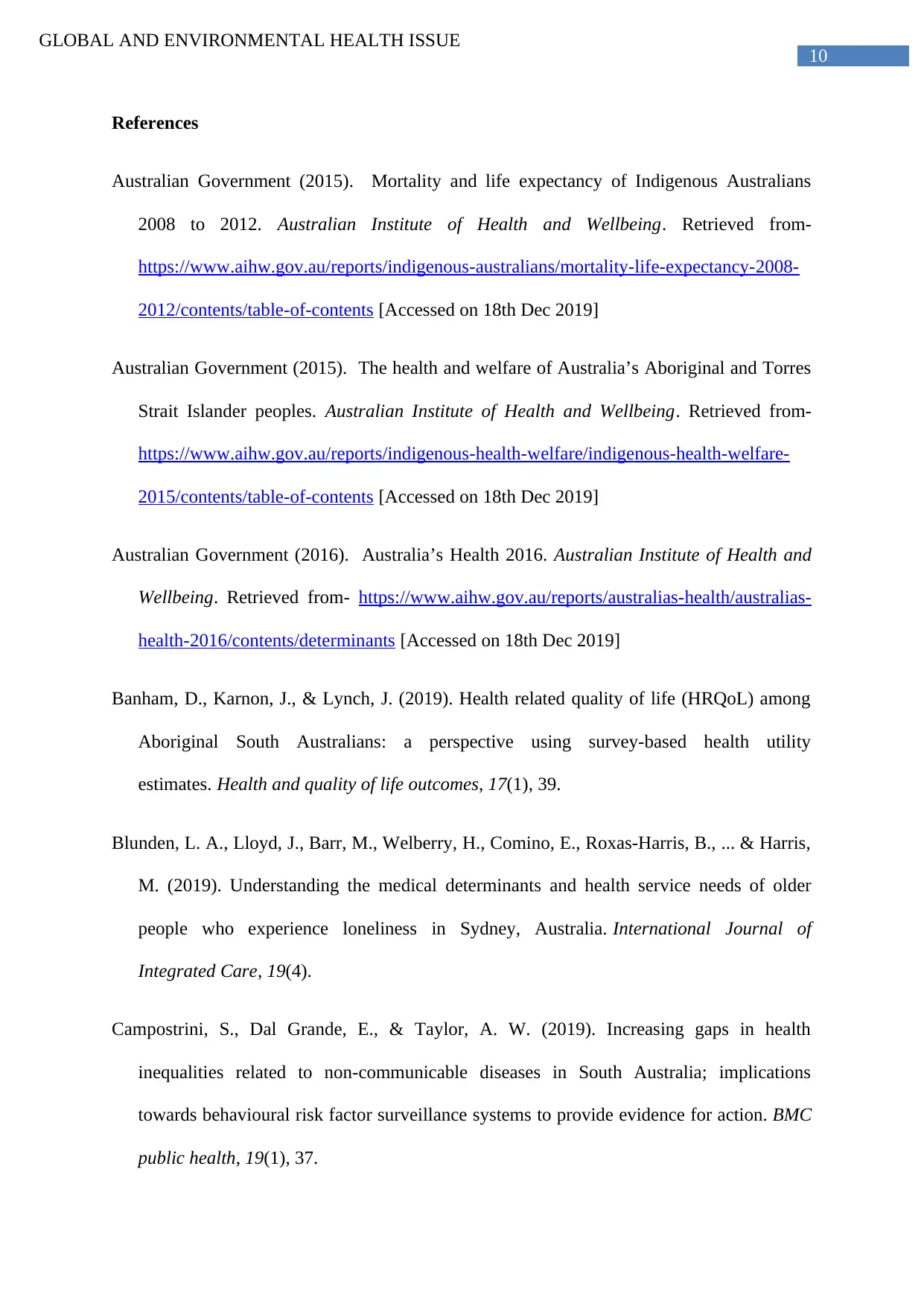
10
GLOBAL AND ENVIRONMENTAL HEALTH ISSUE
References
Australian Government (2015). Mortality and life expectancy of Indigenous Australians
2008 to 2012. Australian Institute of Health and Wellbeing. Retrieved from-
https://www.aihw.gov.au/reports/indigenous-australians/mortality-life-expectancy-2008-
2012/contents/table-of-contents [Accessed on 18th Dec 2019]
Australian Government (2015). The health and welfare of Australia’s Aboriginal and Torres
Strait Islander peoples. Australian Institute of Health and Wellbeing. Retrieved from-
https://www.aihw.gov.au/reports/indigenous-health-welfare/indigenous-health-welfare-
2015/contents/table-of-contents [Accessed on 18th Dec 2019]
Australian Government (2016). Australia’s Health 2016. Australian Institute of Health and
Wellbeing. Retrieved from- https://www.aihw.gov.au/reports/australias-health/australias-
health-2016/contents/determinants [Accessed on 18th Dec 2019]
Banham, D., Karnon, J., & Lynch, J. (2019). Health related quality of life (HRQoL) among
Aboriginal South Australians: a perspective using survey-based health utility
estimates. Health and quality of life outcomes, 17(1), 39.
Blunden, L. A., Lloyd, J., Barr, M., Welberry, H., Comino, E., Roxas-Harris, B., ... & Harris,
M. (2019). Understanding the medical determinants and health service needs of older
people who experience loneliness in Sydney, Australia. International Journal of
Integrated Care, 19(4).
Campostrini, S., Dal Grande, E., & Taylor, A. W. (2019). Increasing gaps in health
inequalities related to non-communicable diseases in South Australia; implications
towards behavioural risk factor surveillance systems to provide evidence for action. BMC
public health, 19(1), 37.
GLOBAL AND ENVIRONMENTAL HEALTH ISSUE
References
Australian Government (2015). Mortality and life expectancy of Indigenous Australians
2008 to 2012. Australian Institute of Health and Wellbeing. Retrieved from-
https://www.aihw.gov.au/reports/indigenous-australians/mortality-life-expectancy-2008-
2012/contents/table-of-contents [Accessed on 18th Dec 2019]
Australian Government (2015). The health and welfare of Australia’s Aboriginal and Torres
Strait Islander peoples. Australian Institute of Health and Wellbeing. Retrieved from-
https://www.aihw.gov.au/reports/indigenous-health-welfare/indigenous-health-welfare-
2015/contents/table-of-contents [Accessed on 18th Dec 2019]
Australian Government (2016). Australia’s Health 2016. Australian Institute of Health and
Wellbeing. Retrieved from- https://www.aihw.gov.au/reports/australias-health/australias-
health-2016/contents/determinants [Accessed on 18th Dec 2019]
Banham, D., Karnon, J., & Lynch, J. (2019). Health related quality of life (HRQoL) among
Aboriginal South Australians: a perspective using survey-based health utility
estimates. Health and quality of life outcomes, 17(1), 39.
Blunden, L. A., Lloyd, J., Barr, M., Welberry, H., Comino, E., Roxas-Harris, B., ... & Harris,
M. (2019). Understanding the medical determinants and health service needs of older
people who experience loneliness in Sydney, Australia. International Journal of
Integrated Care, 19(4).
Campostrini, S., Dal Grande, E., & Taylor, A. W. (2019). Increasing gaps in health
inequalities related to non-communicable diseases in South Australia; implications
towards behavioural risk factor surveillance systems to provide evidence for action. BMC
public health, 19(1), 37.
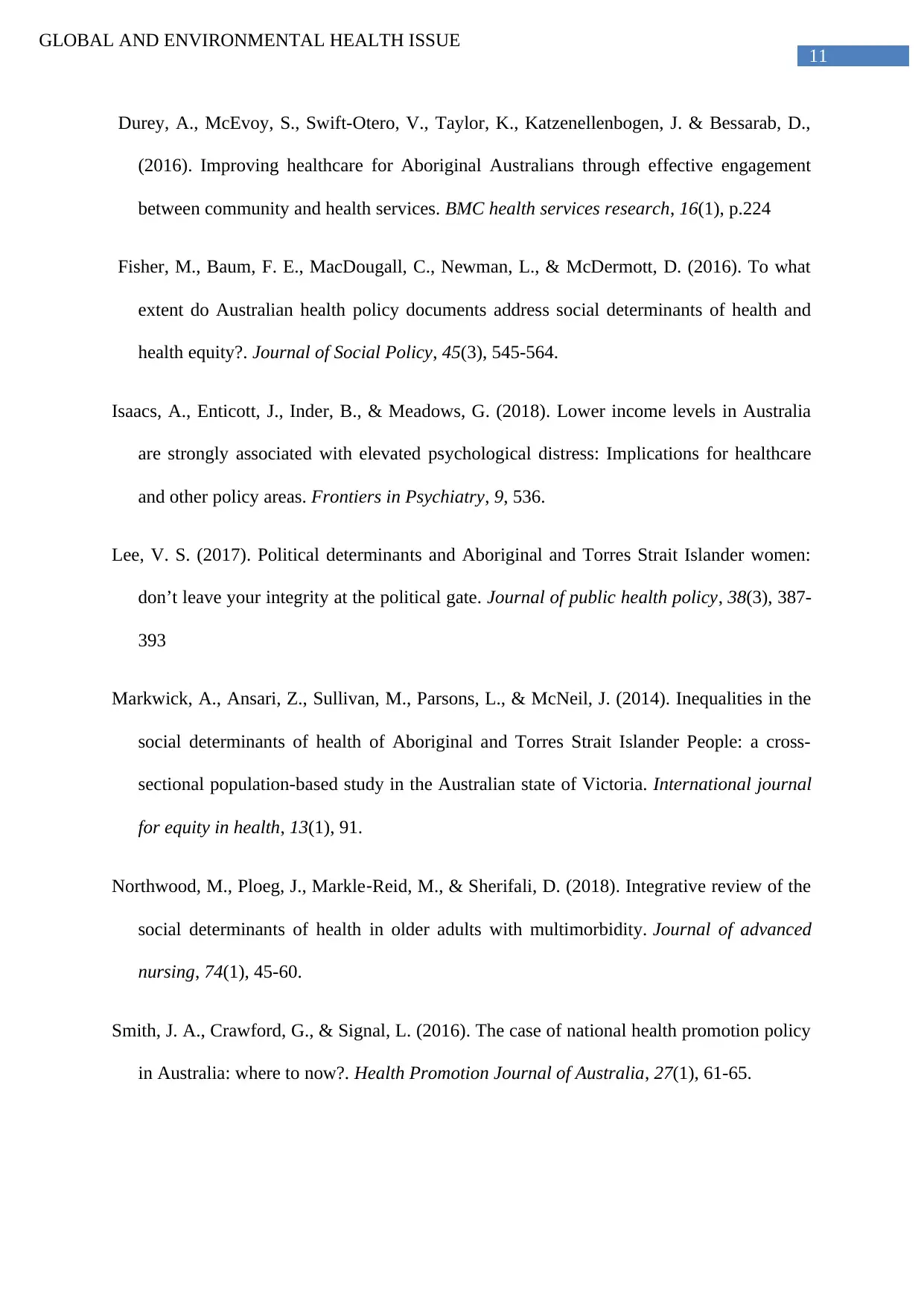
11
GLOBAL AND ENVIRONMENTAL HEALTH ISSUE
Durey, A., McEvoy, S., Swift-Otero, V., Taylor, K., Katzenellenbogen, J. & Bessarab, D.,
(2016). Improving healthcare for Aboriginal Australians through effective engagement
between community and health services. BMC health services research, 16(1), p.224
Fisher, M., Baum, F. E., MacDougall, C., Newman, L., & McDermott, D. (2016). To what
extent do Australian health policy documents address social determinants of health and
health equity?. Journal of Social Policy, 45(3), 545-564.
Isaacs, A., Enticott, J., Inder, B., & Meadows, G. (2018). Lower income levels in Australia
are strongly associated with elevated psychological distress: Implications for healthcare
and other policy areas. Frontiers in Psychiatry, 9, 536.
Lee, V. S. (2017). Political determinants and Aboriginal and Torres Strait Islander women:
don’t leave your integrity at the political gate. Journal of public health policy, 38(3), 387-
393
Markwick, A., Ansari, Z., Sullivan, M., Parsons, L., & McNeil, J. (2014). Inequalities in the
social determinants of health of Aboriginal and Torres Strait Islander People: a cross-
sectional population-based study in the Australian state of Victoria. International journal
for equity in health, 13(1), 91.
Northwood, M., Ploeg, J., Markle‐Reid, M., & Sherifali, D. (2018). Integrative review of the
social determinants of health in older adults with multimorbidity. Journal of advanced
nursing, 74(1), 45-60.
Smith, J. A., Crawford, G., & Signal, L. (2016). The case of national health promotion policy
in Australia: where to now?. Health Promotion Journal of Australia, 27(1), 61-65.
GLOBAL AND ENVIRONMENTAL HEALTH ISSUE
Durey, A., McEvoy, S., Swift-Otero, V., Taylor, K., Katzenellenbogen, J. & Bessarab, D.,
(2016). Improving healthcare for Aboriginal Australians through effective engagement
between community and health services. BMC health services research, 16(1), p.224
Fisher, M., Baum, F. E., MacDougall, C., Newman, L., & McDermott, D. (2016). To what
extent do Australian health policy documents address social determinants of health and
health equity?. Journal of Social Policy, 45(3), 545-564.
Isaacs, A., Enticott, J., Inder, B., & Meadows, G. (2018). Lower income levels in Australia
are strongly associated with elevated psychological distress: Implications for healthcare
and other policy areas. Frontiers in Psychiatry, 9, 536.
Lee, V. S. (2017). Political determinants and Aboriginal and Torres Strait Islander women:
don’t leave your integrity at the political gate. Journal of public health policy, 38(3), 387-
393
Markwick, A., Ansari, Z., Sullivan, M., Parsons, L., & McNeil, J. (2014). Inequalities in the
social determinants of health of Aboriginal and Torres Strait Islander People: a cross-
sectional population-based study in the Australian state of Victoria. International journal
for equity in health, 13(1), 91.
Northwood, M., Ploeg, J., Markle‐Reid, M., & Sherifali, D. (2018). Integrative review of the
social determinants of health in older adults with multimorbidity. Journal of advanced
nursing, 74(1), 45-60.
Smith, J. A., Crawford, G., & Signal, L. (2016). The case of national health promotion policy
in Australia: where to now?. Health Promotion Journal of Australia, 27(1), 61-65.
⊘ This is a preview!⊘
Do you want full access?
Subscribe today to unlock all pages.

Trusted by 1+ million students worldwide
1 out of 15
Related Documents
Your All-in-One AI-Powered Toolkit for Academic Success.
+13062052269
info@desklib.com
Available 24*7 on WhatsApp / Email
![[object Object]](/_next/static/media/star-bottom.7253800d.svg)
Unlock your academic potential
Copyright © 2020–2025 A2Z Services. All Rights Reserved. Developed and managed by ZUCOL.





